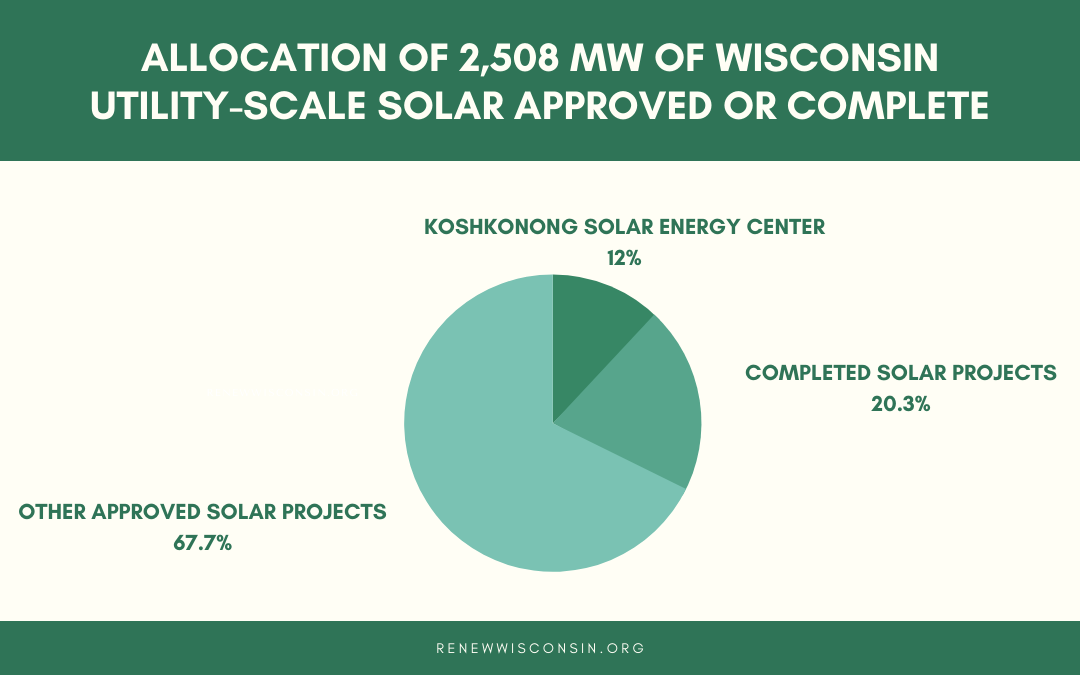
by Heather Allen | Apr 12, 2022 | Energy Storage, PSC Priorities, Public Service Commission, Solar, Utilities, Utility Scale
The Wisconsin Public Service Commission (PSC) approved the construction of the 300-megawatt (MW) Koshkonong Solar Energy Center in early April.
Developed by Chicago-based Invenergy LLC, this solar project will provide enough emission-free electricity to power 60,000 Wisconsin homes. It will become one of Wisconsin’s largest renewable energy generators, representing 12% of Wisconsin utility-scale solar projects that have been completed or approved as of today.
The Koshkonong Solar Energy Center will be located in southeast Dane County. In addition to the 300 MW of solar power, the project will feature a 165 MW battery storage component to help bolster grid reliability. WEC Energy Group and Madison Gas and Electric intend to buy the plant for $649 million.
“This project accelerates the state’s and the region’s transition to clean energy,” said Heather Allen, Executive Director at RENEW Wisconsin. “With enough capacity to provide one-fourth of the local solar needed to meet Dane County’s Climate Action Plan, Koshkonong’s approval is a major milestone in the transition to energy independence for the region.”
When energized, the project will generate $1.2 million per year in new revenue for local governments, in addition to lease payments to local landowners. Construction is expected to begin later this year and will likely become operational in 2025.
“The energy storage component of the project will provide up to 660 megawatt-hours of energy storage per day, or approximately the equivalent battery storage capacity of 6,000 electric vehicles,” Allen added. “Battery energy storage adds more flexibility to the project, allowing for energy use when it is needed most.”
Koshkonong is the fourth solar generation project proposed by Invenergy to receive construction approval from Wisconsin regulators and the third to be combined with an energy storage component. The four solar projects developed by Invenergy—Badger Hollow, Paris, Darien, and now Koshkonong—will comprise 1,050 MW of generating capacity when completed. The energy storage facility at Koshkonong will be the largest of its kind in Wisconsin.
In a separate proceeding, WEC Energy Group and Madison Gas and Electric seek permission to add the Koshkonong Solar Energy Center to their growing portfolio of renewable generating plants. The PSC will likely rule on this application before the end of this year.
In the technical hearing leading up to the PSC’s decision, RENEW provided expert testimony documenting the public benefits to be delivered by the Koshkonong solar and storage project. These benefits include:
- Displacing fossil generation with a zero-carbon source of electricity over its 30-year+ lifetime;
- Providing firm capacity at a Dane County location for replacing the 1,100 MW Columbia coal-fired power plant scheduled for retirement in 2024; and
- Supporting Wisconsin’s farm economy through lease payments to participating landowners and new revenues to local governments hosting the project.
Wisconsin currently has over 510 MW of completed utility-scale solar projects with nearly 2000 MW more approved. This upward trajectory of utility-scale solar projects will help Wisconsin meet its 100% carbon-free goals.
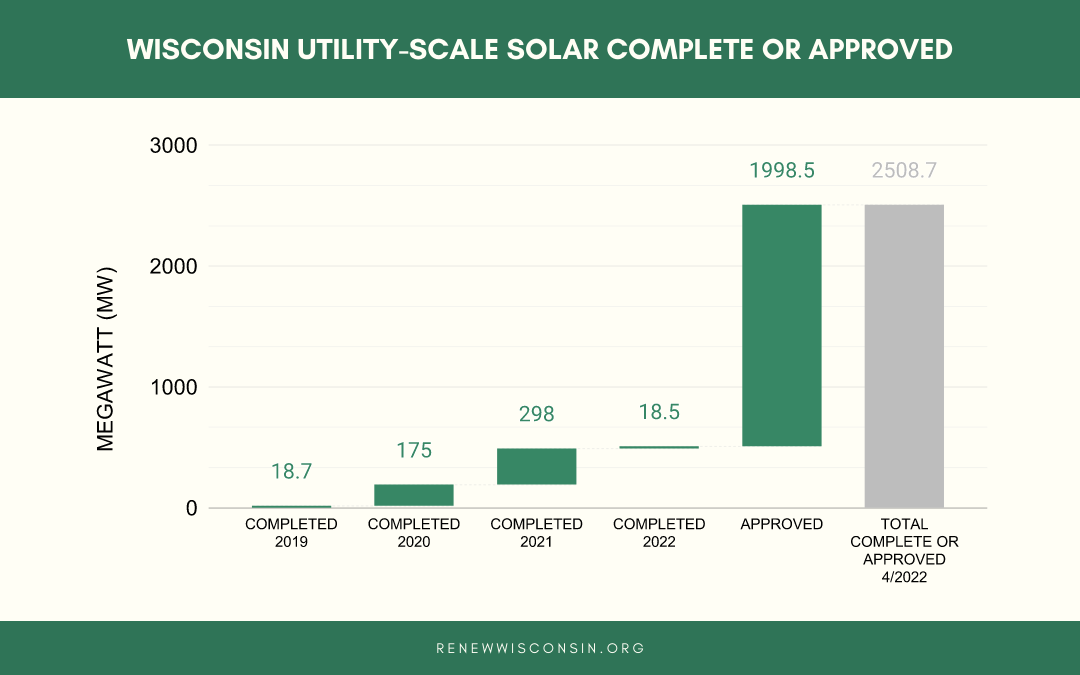
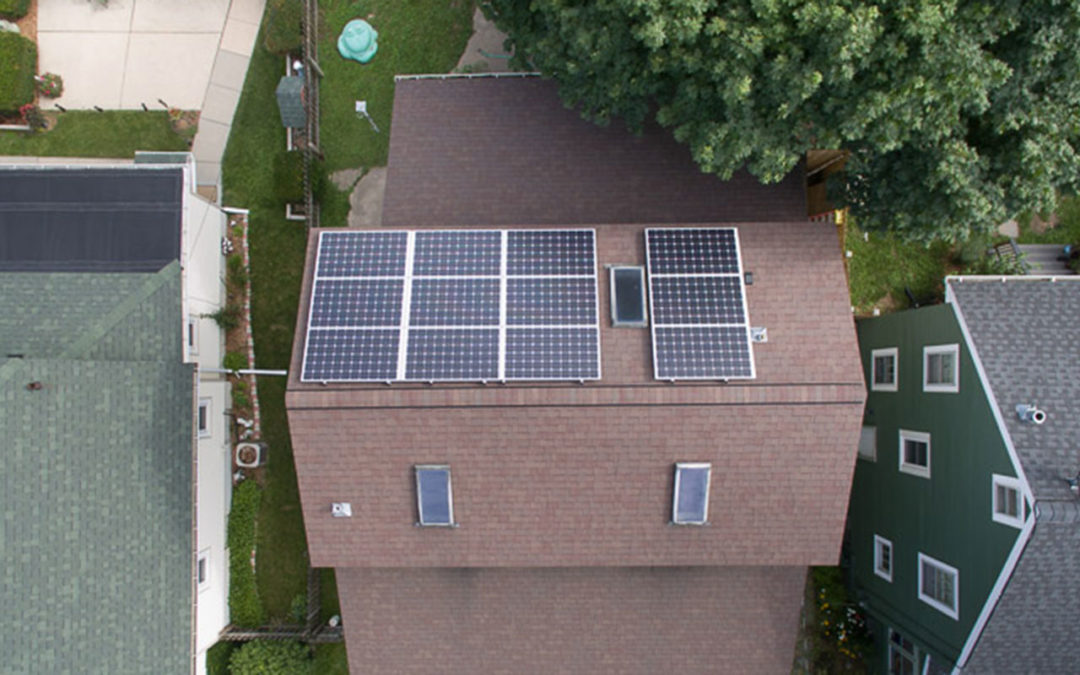
by Andrew Kell | Mar 18, 2022 | Advocacy, Policy, PSC Priorities, Public Service Commission, Solar
In June of 2020, the Public Service Commission of Wisconsin (PSC) opened an investigation into parallel generation (docket 5-EI-157). Parallel generation refers to distributed generation (DG) that is sited at a customer’s premises and can 1) produce energy for the customer’s energy use, and 2) produce and sell to the utility energy that exceeds the customer’s use. The most common type of DG is a solar photovoltaic (PV) rooftop system.
According to the PSC Notice of Investigation, this ongoing parallel generation investigation aims to gather information on costs, markets, emerging technologies, and barriers to DG in the state. A January 2021 RENEW blog described the initial activities in the docket.
After gathering information, the PSC made an initial decision in the docket to further explore:
- avoided costs and buyback rates for DG;
- net metering;
- contracts; and
- consistent terminology and terms of service across the state.
To better understand the value of DG, the PSC directed the five largest investor-owned utilities in Wisconsin to provide modeling and calculations of ‘avoided costs’ and revise the rates at which the utilities purchase energy from DG (also called ‘buyback rates’).
The utility’s buyback rate is a critical economic variable for DG. When homeowners and businesses entertain the idea of solar generation on their rooftops, they must first consider the costs and benefits of installation. The principal economic benefits of installing solar are reducing the energy you buy from the utility and getting paid for the excess energy you sell to the utility. Outside of the net energy billing services available for small installations, most utilities in Wisconsin pay very little for the energy they purchase from DG customers. Utility payments to DG customers don’t recognize the value of local, clean energy, which then oppresses the development of DG and hinders the advancement of carbon reduction goals.
It became apparent that upcoming PSC decisions would reset buyback rates and influence the business case for DG in Wisconsin, potentially for decades to come. As a result, RENEW put together a plan to participate in the utility cases and contracted with GridLab and Synapse Energy Economics to provide expert testimony on the issues.
When the utilities filed their buyback rate applications in early September last year, there were no major surprises to the clean energy community. Rather than model and calculate the long-term avoided costs of local, renewable DG, as the Commission requested, utilities either cited short-term marginal prices for some costs or simply stated that DG provides no value for other costs. RENEW needed to do more than simply critique the utility applications. The RENEW team developed a complete counterproposal for the Commission’s consideration, premised on criteria established by the Commission and just, reasonable buyback rates for DG customers.
Over several months, RENEW collaborated with its consultants and Keyes & Fox, a firm dedicated to clean energy law. Focusing on the Commission’s conceptual framework of avoided energy, generating capacity, and transmission costs, RENEW’s team gathered information, developed and ran market models, and calculated buyback rates. This ensured that RENEW’s proposal would meet the Commission’s requirements and recognize the actual value renewable DG provides to all utility customers.
These efforts resulted in a comprehensive framework for the Commission to consider and adopt for all utilities across Wisconsin. The RENEW team is now submitting testimony and evidence to support this comprehensive framework in all five utility cases.
RENEW now needs your support! The Commission will soon open the public comment period for these five cases and needs to hear from clean energy organizations, climate activists, businesses, and residents across Wisconsin. Below is a list of the five utility cases. RENEW will update the list with dates and direct links to make public comments when the public comment period becomes known. Since Commission decisions in these cases will set a precedent for all utilities in Wisconsin, we encourage you to comment on all 5 cases.
Click on applicable links below to submit comments for each utility.
Energy Policy Nerd Alert!
If you are interested in reading through the details of RENEW’s testimony filings, below are links to direct testimony filings for the case proceeding first (Xcel Energy, aka Northern States Power Company-Wisconsin). Testimony for other cases mentioned above will be available at a later date.
Direct Testimony of Andrew Kell
Direct Testimony of Michael Vickerman
Direct Testimony of Divita Bhandari (Synapse consultant)
Direct Testimony of Rachel Wilson (Synapse consultant)
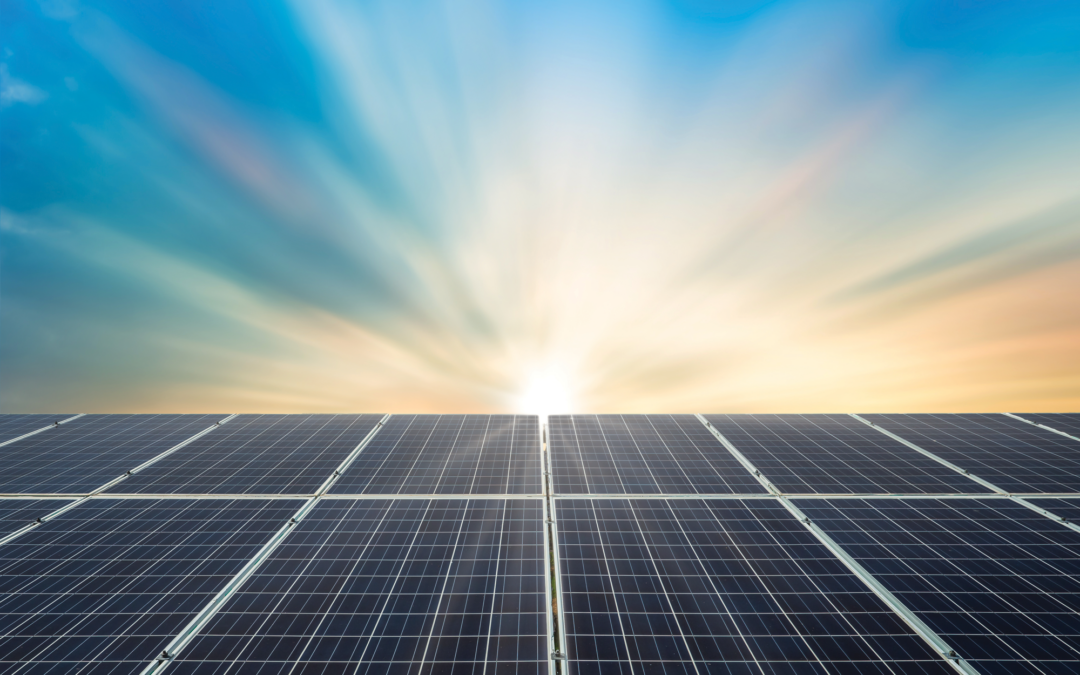
by Sam Dunaiski | Mar 14, 2022 | PSC Priorities, Public Service Commission, Solar
Wisconsin’s rooftop solar photovoltaic (PV) marketplace is still in its infancy. In 2020, rooftop solar generating capacity was approximately 104 megawatts (MW), representing about 1/3rd of one percent (or 0.333%) of all the electricity produced in our state.
However, Wisconsin’s rooftop solar market is growing, with over 10 MW of solar installed on residential homes last year, compared with approximately 5 megawatts in 2019. The combination of Wisconsin’s current rooftop solar capacity and adoption rate in the solar marketplace prompted Wisconsin’s Public Service Commission (PSC) to request a Rooftop Solar PV Potential study. The study provides both technical potential and simulated market adoption analyses.
Technical Potential Study
Nearly 37 gigawatts (GW) of technically feasible rooftop solar capacity would be possible in Wisconsin by 2026. By 2034, another 2 GW[1] of solar would be possible on Wisconsin rooftops, for a total of 39 GW, enough to provide around 70% of our total statewide electricity needs. Unfortunately, only 1.6% of this is projected to be adopted by 2034, given our current set of economic and regulatory factors.
The technical potential study considers all rooftop square footage in the state with less than 20% shade. It does not view houses and facilities that need structural upgrades, electrical upgrades, or new rooftop materials. Nor does it factor in the host utility’s net-metering capacity maximum. Essentially, the study represents the theoretical maximum amount of Wisconsin rooftop solar capacity.
Market Potential Study
The PSC market potential study focused on a business-as-usual scenario and four new economic scenarios that would help drive solar adoption. The new scenarios are as follows:
- A statewide, net-metering policy
- Increased Focus on Energy incentives
- “Attractive” financing (reducing interest rates to 2.5% and requiring no down payment)
- Extending the Federal Investment Tax Credit (ITC) at 26% until 2026.
The statewide net-metering policy demonstrated the best hypothetical outcome for rooftop solar adoption of the four potential scenarios. This net-metering policy would include a 500 kW net-metering cap and an annual “true-up,” meaning excess solar energy could be passed on or “banked” from month to month instead of only day-to-day.
Each of the potential scenarios resulted in increased solar adoption from baseline scenarios, but the standardized net-metering policy resulted in the highest adoption levels. While the other three scenarios represented a 5 – 15% increase in solar capacity, the net-metering approach resulted in a nearly 30% increase in adoption.
The majority of solar potential is concentrated in the residential sector, primarily among single-family homes. Approximately 62% of the technical solar potential comes from single-family homes, with the market-simulated study showing residential solar making up 50% to 70% of the total rooftop solar capacity.
Analysis/Evaluation
Technical and Residential Potential – Under an ideal technical scenario, Wisconsin could reach 265% of its electric capacity and approximately 70% of our total annual electricity production from rooftop solar alone. The technical study doesn’t consider battery storage and other demand-side measures, which could make rooftop solar an even more efficient source of energy than it currently is today.
The potential for rooftop solar in the residential sector is substantial. Utility bills make up a large percentage of many household incomes, especially with more people working from home. Demand-side measures and other energy-efficient upgrades can reduce household utility bills further, speeding our energy transition even more quickly.
Jobs and Equity – Solar installer is already slated to be one of the fastest-growing jobs in the country, and this rooftop solar potential could place additional strains on worker demand. Wisconsin solar contractors are already challenged to find enough qualified employees, especially electricians, and the possibility of adding so much renewable energy to the grid means we’ll need to find people to fill these roles.
Wisconsin will need all hands on deck to build our clean energy future, which will mean making sure underrepresented communities are recruited into this robust workforce. It will be necessary to engage and train rural residents, people from impoverished areas, and people of color. Job programs like Madison’s GreenPower Program are essential to training tomorrow’s workforce, but we will likely need more programs like this moving forward.
Incorporating gigawatts of rooftop solar will also improve the health and futures of Wisconsin residents. In particular, studies have shown that fossil fuel generation sources, like coal and gas plants, are much more likely to be sited in lower-income communities, resulting in many poor health outcomes for members of those communities. Adding widespread, distributed rooftop solar to our energy mix will allow many fossil fuel plants to be decommissioned and taken offline. Plus, marginalized communities will share in the economic benefits that rooftop solar can have on utility bills.
Net-metering potential – From an economics perspective, net-metering is a highly beneficial tool for behind-the-meter solar installations, especially in the residential sector. Net-metering has positive impacts for both the consumer and the utility; rooftop solar provides additional capacity value for utilities when the grid needs it most (typically afternoons). It allows customers to receive credit for the excess electrons they produce and provide to the grid. This is why RENEW Wisconsin has advocated for a standardized, statewide net-metering policy for customer-owned solar arrays.
The findings in this report related to net-metering show the true value net-metering has on rooftop solar systems, especially those installed on residential dwellings. The net-metering scenario creates around 650 MW of new solar production, nearly 40% more than a business-as-usual scenario which only yields about 450 MW of rooftop solar capacity. This study shows a standardized net-metering policy would also have more dramatic and long-term effects on household utility bills than other scenarios considered, including increased tax credits or higher Focus on Energy incentives. This is especially true among income-qualified households, where a significant portion of monthly income goes towards utility payments.
RENEW hopes that the technical and market potential study findings will help bolster much of our regulatory work on the Parallel Generation docket at the Public Service Commission. RENEW advocates for an all-of-the-above approach to transitioning away from fossil fuel. Both utility- and customer-owned renewable energy sources will be needed to decarbonize our energy sector. This study shows that rooftop solar has a much more significant potential than previously thought and demonstrates how vital these installations will be over the next few decades.
[1] These increases in projections were primarily due to load growth and efficiency improvements in solar panels.

by Andrew Kell | Nov 10, 2021 | Advocacy, Community, Focus on Energy, Local Government, Policy, PSC Priorities, Public Service Commission
In 2019, Governor Evers issued Executive Order #38 to establish a goal for carbon-free electricity in Wisconsin by 2050. As the state regulator of utilities, the Public Service Commission (PSC) is tasked with regulating the number one sector source for greenhouse gas emissions in Wisconsin[1]. As a result, PSC decisions play a key role in determining whether Wisconsin will be able to achieve a zero-carbon grid by 2050.
The PSC reviews utility proposals for construction projects, rate increases, and new utility programs for their customers. However, the PSC reviews these proposals separately from one another, and historically without the integration of other utility plans, carbon reduction goals, and cross-sector emission-reduction strategies. The good news is that the PSC has begun to explore how to incorporate these factors within its decision-making processes going forward.
In keeping with a recent trend of investigating policy issues (such as Electric Vehicles and Parallel Generation), this past spring the PSC opened a docket (5-EI-158) to pursue a “Roadmap to Zero Carbon.” As described in the Notice of Investigation, the PSC intends to evaluate government and utility goals to reduce carbon emissions to zero by 2050, recommendations from recent Wisconsin reports on clean energy and climate change, and the development of partnerships to achieve carbon-free electricity by 2050.
The Zero Carbon Roadmap docket garnered much interest from active PSC intervenors (such as RENEW), with participation from environmental, health, and business advocates as well. Members of the general public also participated with input and suggestions. PSC staff issued a memo for public comment on scoping of priorities. After gathering public input, PSC staff issued a follow-up memo to the Commissioners in August that summarized stakeholder input and provided the Commissioners with options on the next steps. The Commissioners then discussed the memo and issued an order in September to take some initial actions.
In short, the PSC decided to leverage ongoing planning processes and to investigate a potentially new approach to utility ratemaking. Below is a summary of these initial steps:
- The PSC will gather more robust carbon-reduction planning information from utilities during the current biennial Strategic Energy Assessment (SEA). Utilities will soon respond to the PSC staff’s initial data request, and PSC staff will issue a draft report by next spring for public comment;
- Additionally, the PSC will seek public input on ways in which the state’s Focus on Energy program (Focus) can better incorporate beneficial electrification, programs for low-income customers, demand response, and other utility voluntary programs into its program design over the next four years. This is called the Quadrennial Planning Process, and a PSC staff recently issued a memo for comment on scope; and
- Finally, the PSC will organize a workshop on Performance-based Regulation (PBR). This workshop will gather information and perspectives on how rethinking utility goals and investment incentives can lead to a more equitable clean-energy future. The PSC will also consider customer affordability issues in relation to the transition to a zero-carbon grid.
Even with these planning processes already underway, the book is not closed on the Roadmap to Zero Carbon docket. RENEW recently reached out to Joe Fontaine, PSC Policy Advisor, to get a better sense of next steps for the investigation docket itself. Fontaine said:
“Commission staff is excited to kick off the Roadmap by addressing four of the highest priorities identified by commenters and approved by the Commission. Each of these four areas — more transparent resource planning, development of performance-based regulation concepts, and further analysis of affordability and energy efficiency issues — can help us develop a strong general foundation to address a wider range of issues related to the clean energy transition, in this investigation as well as in other Commission dockets. Future decisions in the Roadmap will be well-informed by the analysis and stakeholder input we’re receiving at each step in the investigation. Potential next steps will be determined as we make progress on these initial priorities over the next few months.”
The PSC’s Roadmap to Zero Carbon activities is running in parallel with the Office of Sustainability and Clean Energy’s (OSCE) Clean Energy Plan drafting process. Beyond the electricity sector, the Clean Energy Plan will assess, and make recommendations on, strategies cutting across all economic sectors statewide. The OSCE recently gathered public input during several public listening sessions, focusing on 1) economic and environmental justice, 2) infrastructure and industry, 3) transit and transportation, and 4) clean energy and energy efficiency. The OSCE continues to gather written comments through its website.
RENEW is also proactively partnering with Clean Wisconsin and GridLab to conduct a zero-carbon grid study for the PSC’s consideration. While the scope is still being finalized, the study will use modeling designed to answer important policy questions, such as:
- What is the right mix of renewable resources in-state and out-of-state?
- What is a good balance between utility-scale and distributed solar resources?
- How much transmission is needed in a zero-carbon future?
- What will be the health, jobs, and economic impacts as we make this clean grid transition?
Stay tuned on these zero-carbon planning activities and upcoming study developments. RENEW plans to organize presentations and panel discussions on these topics at our Renewable Energy Summit on January 27, 2022.
[1] See the Department of Natural Resources’ Wisconsin Greenhouse Gas Emissions Inventory Report of August 2020. Figure 1, on page 3, presents emissions by sector. Electricity generation is the highest emitting sector and represents 33 percent of all Wisconsin emissions.
by Andrew Kell | Sep 13, 2021 | PSC Priorities, Public Service Commission, Renewables, Solar, Utilities
In a stunning policy reversal, Madison Gas and Electric (MGE) submitted a proposal to lower monthly charges and raise energy rates for its residential electric customers. Filed on September 3rd, MGE’s rate application is strongly backed by customer groups and clean energy organizations, including RENEW Wisconsin.
MGE’s filing is the product of negotiations over the summer with RENEW and other parties intervening in the case. If approved as is by the Public Service Commission (PSC), the agreement will pare the fixed charge for residential electric service from $19 per month today to $17 per month in 2022 and $15 per month in 2023. At the same time, energy rates will rise to offset the proposed reduction in the fixed charge.
The monthly fixed charge is the minimum amount assessed on residential customers for electric service. These charges do not vary with energy consumption levels. Hiking fixed charges invariably depresses the volumetric rate assessed to energy consumption, penalizing customers who use relatively little electricity and those who supply themselves with solar power produced onsite. Alternatively, lowering fixed charges and raising energy rates should achieve the opposite result by sending a stronger price signal to incentivize customer investments in energy efficiency and onsite solar.
“Low-income customers, solar customers, and customers who have invested in energy efficiency to reduce energy bills will benefit from this shift,” said Heather Allen, Executive Director for RENEW Wisconsin. “Overall, MGE customers will benefit because reduced energy demand helps limit the need for additional generation capacity. This is a win-win.”
The settlement avoids a contested case hearing in which Citizens Utility Board (CUB) and RENEW had been planning to submit testimony demonstrating that the $19 per month charge was excessive, especially in an urban service territory where the majority of electric customers are renters living in multifamily dwellings.
The MGE settlement follows a similar one struck with Xcel’s Wisconsin utility several months ago. Under the terms of that settlement agreement, which RENEW, CUB and other organizations signed onto, Xcel agreed to lower its fixed charge for residential electric service from $17 per month to $16 per month in 2022 and $15 per month in 2023. As with MGE, Xcel’s energy rates will also increase.
Other positive outcomes of the settlement include MGE’s support for a low-income thermostat pilot program, exploration of further innovative ways to help low-income customers achieve lower energy bills, and MGE’s increased support for smart thermostats and technologies, such as controlled water heaters, heat pumps, and battery electric storage in future filings.
The PSC is now accepting public comments on the MGE rate case. If you’d like to support the settlement agreement, please communicate your thoughts to the PSC via this public comment webpage specific to this case. For more information on the MGE rate case, see the Wisconsin State Journal article here.
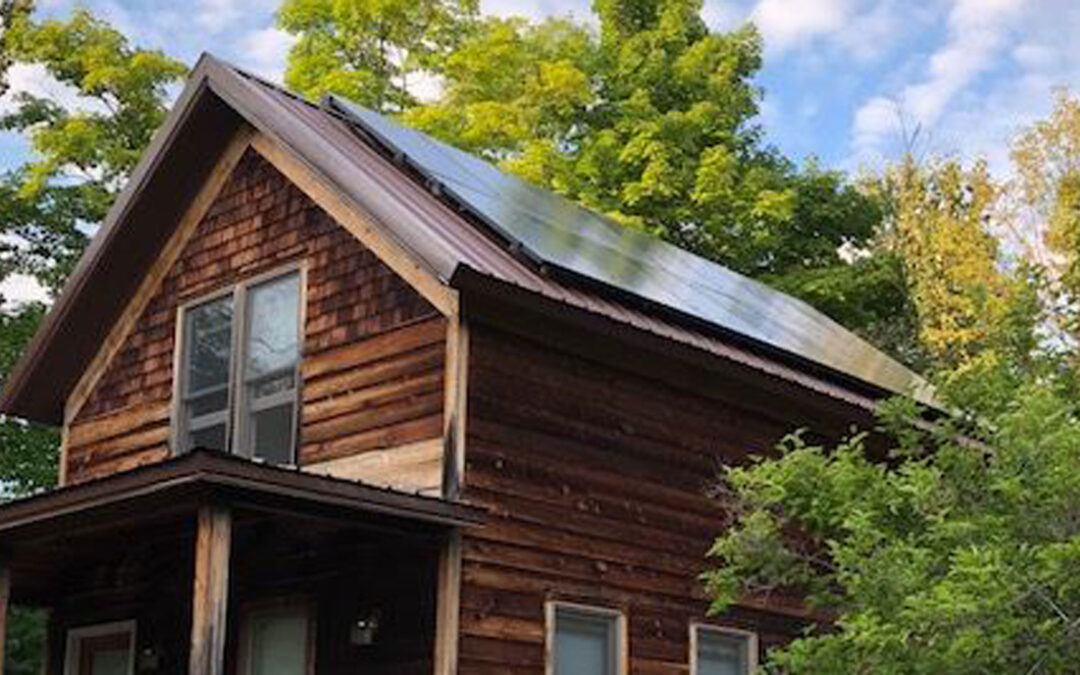
by Andrew Kell | Jul 28, 2021 | Focus on Energy, Policy, PSC Priorities, Public Service Commission
On June 29, 2021, RENEW Wisconsin hosted a webinar titled “Focus on Energy: Economic Impact in Wisconsin.” Dan York from American Council for an Energy Efficient Economy (ACEEE), Scott Blankman from Clean Wisconsin, and Maddie Wazowicz from Midwest Energy Efficiency Alliance (MEEA) provided an overview of the Focus on Energy program. In particular, Wazowicz provided pre-publication results of an upcoming Synapse Energy Economics report analyzing utility bill savings and associated efficiency of business and utility operations that would result from an increase in Focus on Energy’s annual funding.
In his introductory remarks, ACEEE’s York noted that “An analysis conducted a few years ago by the Lawrence Berkeley National Lab found that Focus on Energy was the most cost-effective program serving utility customers in the U.S.” Dan went on to say that according to ACEEE’s own state efficiency scorecard analysis, “while other states have increased their investments and associated spending for customer energy efficiency programs, such funding in Wisconsin has been largely static, locked in by the legislation that created Focus on Energy.” MEEA’s Wazowicz compared Midwestern states’ energy efficiency investments and discussed what an increase of the Focus on Energy budget could mean for Wisconsin.
To understand what additional benefits could be realized from expanding the Focus on Energy program, we can look at results from the upcoming Synapse report. The figure below uses information from a slide presented by Maddie Wazowicz at the webinar and represents pre-publication results from the Synapse study. It shows that doubling the Focus on Energy budget would translate to $20.7 million in annual utility bill savings for Wisconsin utility customers. Of that, $16.95 million in yearly utility bill savings would be realized by Wisconsin businesses if the Focus on Energy budget were doubled! This is what Wisconsin customers would save on top of savings occurring at current Focus on Energy investment levels.
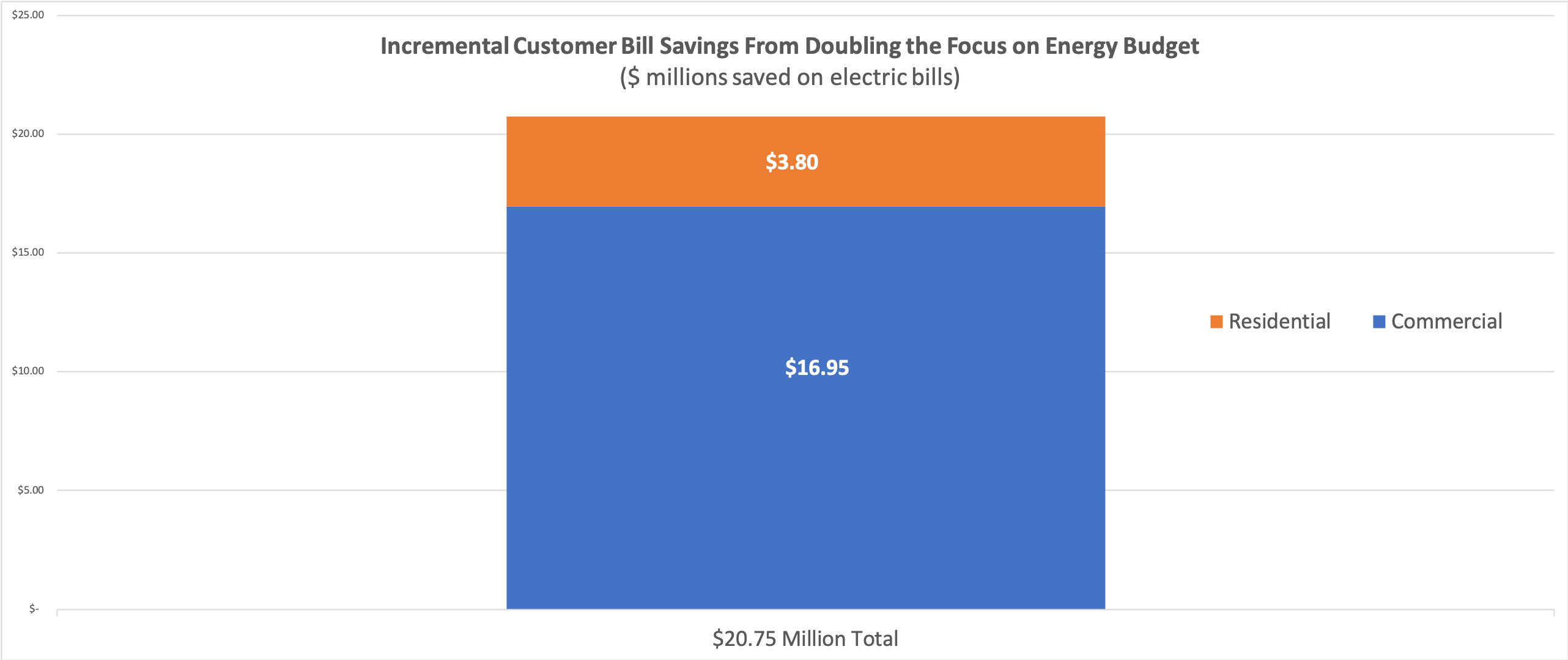
The August Synapse report details avoided utility costs, job creation, economic investment, and reduced air emissions associated with an increase in the Focus on Energy budget. Overall, the report finds that if Wisconsin doubled the Focus on Energy budget the state would receive $340 million dollars in net benefits over one year or $3.4 billion over ten years. Investing in Focus on Energy means a more clean and efficient Wisconsin economy for everyone!
The webinar then transitioned to a discussion of direct economic impacts for Wisconsin business. York moderated a panel of Wisconsin business representatives, who described their experience with the program’s energy efficiency and renewable energy incentives. The panel included Sean Hyland from American Family Insurance, Charles McGinnis from Johnson Controls, Benjamin Reynolds from Reynolds Transfer and Storage, and Tim Ulrich from Cree Lighting.
One of the hot topics of the business panel’s discussion related to data management combined with energy efficiency measures and occupancy sensors. Johnson Control’s McGinnis said that the objective of these combined technologies is to “reduce the amount of energy consumption, for the appropriate amount of occupancy, so that you can optimize the size of renewable energy application to produce green electricity.” Panelists discussed their experience with sustainability programs and performance-based metrics. In combination with his experience with the Focus on Energy program, Benjamin Reynolds described his experience with the Wisconsin Sustainable Business Council and its Green Masters Program. According to Reynolds, the Green Masters Program “is aimed at helping small-to-medium-sized businesses implement sustainability, and figure out ways to improve in energy efficiency, but also improve in waste and other performance metrics.”
Focus on Energy Impact in Wisconsin
This webinar was prompted by calls by supporters to increase funding for Focus on Energy. A RENEW blog post, penned by Michael Vickerman in October of 2020, detailed success stories and energy savings benefits realized by several Wisconsin breweries, such as Capital Brewery in Middleton, WI. That blog post referenced findings of numerous third-party evaluator annual reports on the program. These reports have found that for every dollar invested in Focus on Energy, Wisconsin receives $4 to $5 in economic and environmental benefits. That cost-to-benefit ratio represents a considerable success, as well as a huge opportunity for expansion!
The RENEW blog post also highlighted a recent review of the program by Chair Rebecca Valcq of the Public Service Commission and her request that Governor Evers propose doubling the Focus on Energy budget. Chair Valcq also recently published an op-ed in WISPOLITICS, an online journal, highlighting the economic benefits of Focus on Energy and why an increased investment is needed.
Focus on Energy is currently funded by utilities at about $95 million per year, and funding level changes can only be done through legislation. The Governor followed up on calls to increase Focus on Energy funding by doing just that with his proposed 2021-2023 budget, which RENEW highlighted in a blog post about public listening sessions earlier this year.
This past spring, legislators decided to omit all Governor Evers’ clean energy provisions from its own proposed budget, which unfortunately meant leaving an important economic growth opportunity on the cutting room floor after Governor Evers signed the state budget earlier this July.
Since its inception in 1999, Focus on Energy has fueled a more energy-efficient economy in Wisconsin. The program was created with bipartisan support and can help grow the economy once again with increased funding. Since doubling the Focus on Energy funding was not part of the state budget this year, legislators on both sides of the aisle can prioritize supporting a stand-alone piece of legislation. A clean, growing economy should be something we can all get behind!
For more information, contact Andrew Kell, RENEW Wisconsin’s Policy Analyst, andrew@renewwisconsin.org.







